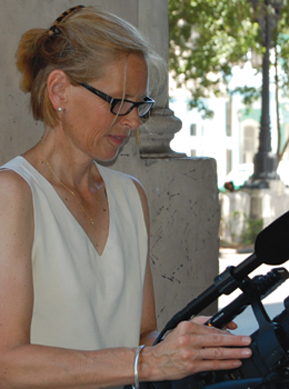Filming los Bailaríns de Cuba
COM prof's documentary gets up close with aspiring ballet dancers

While Cuba seems poised to encounter immense social changes in the coming years, many of the island’s traditions remain intact — including training internationally acclaimed ballet dancers. This is the subject of Mary Jane Doherty’s latest project. Over a span of three years, Doherty, a College of Communication associate professor of film, is documenting the lives of six children between the ages of 9 and 15, all of whom hope to become stars in Cuba’s National Ballet. She chanced upon a newspaper article about Cuban dancers who had defected to the United States and realized that the topic of ballet in Cuba, with its strong visual and emotional appeal, would be ideal for a documentary. “The movie came with visuals and music built in,” Doherty says. “I could show how Cubans move and hear music, the things you cannot describe in words.”
She compares ballet’s place in Cuban culture to that of professional sports in the United States. Principal dancers are national celebrities, and for many children and parents, ballet represents a ticket out of a life in which ration cards determine access to basic needs. Based on the Soviet model, Cuba’s system of ballet schools provides talented youngsters with rigorous training at no cost. But it is extremely competitive.
Around the age of six, children audition for entry to local ballet schools. If accepted, they spend hours in the studio every day preparing for another audition, at age 15, for entrance to the National School of Ballet. Over the course of the filming, several of Doherty’s subjects try for a coveted place at the National School; for those who are unsuccessful, years of arduous training come to an abrupt end, along with their hopes for a better life.
Doherty’s primary intention as a filmmaker is to engage. Like her previous films, this project is a “narrative documentary” that aims foremost to reach the audience emotionally. She avoids interacting with her subjects — whom she calls her characters — through interviewing or other methods familiar to traditional documentaries. The fourth wall, as it were, remains in place, although the narrative unfolding behind it is entirely real.
Narrative documentaries pose a distinct challenge to the filmmaker, who must capture significant moments in the characters’ lives and weave them into a coherent story line, without the benefit of preproduction or multiple takes. To do so, says Doherty, requires “an equal partnership between filmmaker and subject.” On each of her seven visits to Cuba in the first year, she was greeted with a sense of trust and intimacy that she describes as “almost uncanny.” All six dancers invited her into their homes to film their private lives. But in order to maintain this trust and portray their lives honestly, Doherty had to be careful to remain an observer and avoid manipulating the film’s narrative.
"Somehow, my dancers understand the process — they tell me not to worryif I’m too close," she says. "The filming process is intensely intimate, whichmakes for lovely footage, but I want to say to them, ‘Hang on here, youshouldn’t let me be so close to you.’ I feel protective for them, fromme."
But having found what she calls “a natural story,” Doherty lets the events unfold before her. “For the first time in my life,” she says, “the film is walking into my camera by itself.”
A version of this story was originally published in Research at Boston University 2008 magazine.
Comments & Discussion
Boston University moderates comments to facilitate an informed, substantive, civil conversation. Abusive, profane, self-promotional, misleading, incoherent or off-topic comments will be rejected. Moderators are staffed during regular business hours (EST) and can only accept comments written in English. Statistics or facts must include a citation or a link to the citation.